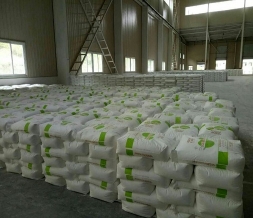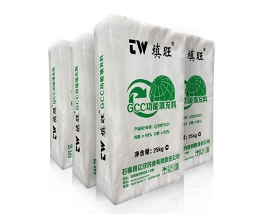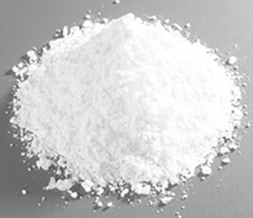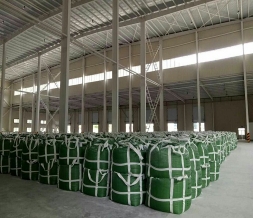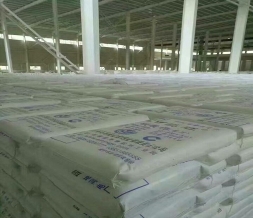As an excellent filler, nano calcium carbonate has the advantages of pure
white color, easy coloring, stable chemical property, low cost, controllable
particle size and particle shape, and has been successfully applied in rubber,
plastics, paints, inks, papermaking, etc. field. Given the superior performance
of nano calcium carbonate. More potential value is also becoming a development
hotspot.
1. Classification by preparation method
(1) Chemical methods
It is divided into five methods: carbonization method, Surve method,
calcium method, caustic method and calcium chloride-soda method. The most used
one is carbonization method, followed by calcium chloride-soda method, and the
other three methods are applied. Rarely, here we mainly introduce the production
principle of carbonization.
The calcium carbonate prepared by the carbonization method is called light
calcium carbonate or precipitated calcium carbonate, and the basic method is as
follows:
Lime firing: CaCO3 - CaO + CO2+Q1
Digestive reaction, also known as ash reaction: CaO+H2O-Ca(OH)2+Q2
Carbonization reaction: Ca(OH)2 + CO2 - CaCO3↓+ Q3
2 Solvay, the joint production of calcium carbonate in the process of
producing soda ash. The chemical reaction process is as follows:
3 calcium method. Calcium carbonate is produced from waste lime sludge and
cheap hydrochloric acid in the chlor-alkali industry. The hydrated lime is
treated with hydrochloric acid to obtain a calcium chloride solution, and the
calcium chloride solution is carbonized by carbon dioxide after inhaling ammonia
gas to obtain calcium carbonate precipitation. The chemical reaction process is
as follows:
4 caustic soda method. In the production process of caustic soda (NaOH),
by-product light calcium carbonate can be obtained. That is, adding slaked lime
to the soda ash aqueous solution can form a calcium carbonate precipitate, and
at the same time, obtain a caustic soda aqueous solution, and finally the
calcium carbonate precipitate is dehydrated, dried and pulverized to obtain a
light calcium carbonate. The chemical reaction process is as follows:
5 calcium chloride - soda method. Calcium chloride is added to an aqueous
solution of soda ash to carry out metathesis reaction, and rapid cooling is
carried out to form an amorphous calcium carbonate precipitate, which is then
dehydrated, dried and pulverized to obtain precipitated calcium carbonate.
In summary, the main features of the light calcium powder produced by the
above chemical methods are:
a small particle size, generally average particle size below a few
microns;
b narrow particle size distribution, can be regarded as monodisperse
powder;
c Particle crystals are diversified and used in different industries to
require different crystal forms.
(2) Physical methods
It is also known as the grinding method, that is, the product obtained by
mechanical pulverization of natural minerals directly, because its specific
gravity is greater than light calcium, it is called heavy calcium carbonate
(referred to as heavy calcium, GCC). The processing process is divided into dry
grinding method and wet grinding method. The products are divided into common
types, such as double fly powder 200 mesh, three fly powder (325 mesh, 45~125
μm), fine powder (325~1250 mesh, 10~45 μm). ), ultra-fine type (>1250 mesh,
2~10μm), ultra-fine active type (surface activation treatment).
The powder characteristics of heavy calcium are:
1 particle shape is irregular;
2 The particle size distribution is relatively wide and is a
multi-dispersion;
3 The particle size is thicker than light calcium, and the same is
ultra-fine calcium carbonate. The particle size of ultra-fine calcium is one
level different from that of ultra-fine light calcium, that is, the particle
size of ultra-fine calcium is only equivalent to the particle size of fine light
calcium. Heavy calcium also has the characteristics of low price, easy
preparation, and investment of only 1/4 to 1/3 of light calcium.
At present, GCC's production and market share are much larger than PCC, but
even the most advanced grinding process in the world can only make GCC reach
about 1μm, so GCC has no reinforcing effect, if used in rubber, plastic,
high-grade coatings and other fields. It can only play the role of filling and
compatibilizing; due to the excellent nano-material properties such as
controllable, semi-reinforcing and reinforcing effects of ultra-fine light
calcium, it is currently not available in heavy calcium, so although its price
is much higher In the case of heavy calcium, the production technology is much
more complicated, but it cannot be replaced by heavy calcium in the functional
fillers used in many medium and high-grade products, and it is also the root of
the development of ultra-fine light calcium.
2. According to whether to carry out surface treatment classification
Ordinary precipitated calcium carbonate and activated calcium carbonate
(abbreviated as activated calcium, Activate Calcium Carbonate referred to as
ACC; or Surface Coated Calcium Carbonate, referred to as SCCC), hydrophilicity
and hydrophobicity are used to judge whether or not to activate. Active calcium
carbonate, also known as modified calcium carbonate, surface treated calcium
carbonate, colloidal calcium carbonate or Bai Yanhua, because active calcium
carbonate has a certain degree of reinforcing effect, therefore, it is customary
to call activated calcium carbonate as modified calcium carbonate. . Active
calcium has the characteristics of small particle size, low oil absorption, good
dispersibility and reinforcement.
3. Classified by their specific use
(1) Calcium Carbonate, Rubber
(2) Calcium Carbonate, Plastic, GCC, can be subdivided into PCC, GCC for
PVC, PCC, GCC for PC and GCC for PC.
(3) Dope Calcium Carbonate: It can be further subdivided into calcium for
paint and calcium for paint.
(4) Calcium-based calcium, also known as Calcium Carbonate, Printing.
(5) Calcium Carbonate (Paper): PCC and GCC for papermaking.
(6) Edible Calcium Carbonate, calcium gluconate, calcium lactate, and the
like.
(7) Medicinal Calcium Carbonate, such as fermented calcium carbonate for
the production of antibiotics.
(8) Biologic Calcium Carbonate, such as capsule-specific calcium,
bio-calcium tablets, etc.
4. Classification according to the crystal form and morphology of calcium
carbonate
For nanometer calcium carbonate, crystal form is an important technical
indicator. Because different crystal forms of the product are suitable for
different application fields, only the specific product crystal form can be
determined according to the specific use, in order to produce a marketable
product. Due to the different processing methods and crystallization conditions,
the original particles (also called primary particles) of the product have
different shapes, and different effects are reflected in the application. There
are three crystal forms of calcium carbonate: calcite, aragonite, and gangue,
which belong to the three-way, orthogonal and hexagonal crystal systems, but
there are dozens of their appearances, and the following eight crystal forms are
common.
(1) Irregular calcium carbonate
That is, natural calcite, limestone, marble, chalk, etc. are used as raw
materials, which are mechanically pulverized or air-pulverized to a certain
fineness standard. Because they are heavier than precipitated calcium carbonate,
they are named heavy calcium carbonate, heavy fine calcium carbonate, etc. They
are all irregular bodies. Under the electron microscope, the difference in
particle size can be observed, and there is a certain angular angle outside the
particle. The specific surface area of GCC is small, about 1 m2/g, and the oil
absorption value is about 20 to 27 ml/100 g. The average particle size of FGCC
can be up to 3 μm, the specific surface area is 1.45 to 2.1 m2/g, and the oil
absorption value is about 48 ml/100 g.
In short, GCC has the characteristics of irregular shape, wide particle
size distribution, high density, small specific surface area, and low oil
absorption.
(2) spindle-shaped calcium carbonate
Ordinary light calcium products, without adding any crystal-oriented agent,
the crystal form is two-pointed, such as a spindle. The long diameter is 5 to 12
μm and the short diameter is 1 to 3 μm. If the added crystal control agent is
H2O2, a chelating agent, etc., a small spindle having a short diameter of 0.1 to
1 μm can be obtained, and the particle diameter is 100 to 1000 nm, and the
aspect ratio is 3 to 4. No secondary condensation occurs during the drying
process. The dispersion is very good.
(3) cubic calcium carbonate
In the early stage of the carbonization reaction, a sulfuric acid salt such
as sulfuric acid or aluminum sulfate or zinc sulfate or a crystal forming agent
such as sodium polyphosphate is added to the calcium hydroxide slurry to produce
a cubic ultrafine calcium carbonate product having a particle size of 5-100nm,
uniform particle size, good dispersibility, and low oil absorption. Japan
Shiraishi Industrial Co., Ltd. uses Al2(SO4)3 or ZnSO4 as a crystal forming
agent to prepare a cubic nanometer calcium carbonate having an average particle
diameter of 5-20 nm by a two-stage spray carbonization method. Zheng Yu et al.
prepared a cubic nano-calcium carbonate with an average particle size of 45 nm
by using a sulfuric acid as a crystal-oriented agent.
(4) Needle-shaped calcium carbonate
Also known as whisker-like calcium carbonate: Ultrafine needle-like calcium
carbonate crystals can be obtained by using a sodium pyrophosphate solution, or
a ruthenium chloride solution or a sodium sulfate solution as a crystal forming
agent. Xu Jun, Fujian Normal University, etc., can use the urea hydrolysis
method to prepare high-purity whisker calcium carbonate in a steam pressure
cooker under constant high temperature and high pressure without adding a
crystal forming agent.
Acicular nano-calcium carbonate has the advantages of high whiteness, low
production cost, high strength and good filling performance, and is expected to
replace fiber materials such as glass and asbestos and expensive whisker
materials such as potassium titanate and titanium carbide (TiC). It is widely
used in industrial fields such as paper, plastics, rubber and paint. It is
reported that the price of whisker calcium carbonate produced by a company in
Hunan is more than 10,000 yuan per ton.
(5) Chain-locked calcium carbonate
Nano-chain-locking can be obtained by adding an additive such as sodium
hexametaphosphate, ethylenediaminetetraacetic acid and aluminum chloride, or
cis-succinic acid in the early stage of the carbonization reaction, or adding
aluminum trichloride in the carbonization process. Ultrafine calcium carbonate.
Research by Cui Aili and others of Tsinghua University showed that after forming
single-particle crystallites in the initial stage of carbonization reaction,
AlCl3 was added and AlCl3 was hydrolyzed to form Al(OH)3. Due to the bonding of
Al(OH)3, a small particle microcrystal was connected. A chain-locked calcium
carbonate which is loosely bonded in a certain direction from several to several
tens of ultrafine cubic crystals, and has an average particle diameter of 10 to
100 nm and an aspect ratio of 1:5 to 50.
(6) spherical calcium carbonate
In the metathesis reaction of CaCl2 and Na2CO3 as raw materials for the
production of calcium carbonate, EDTA and Na2HPO4 are added to the Na2CO3
solution, and then the CaCl2 solution is added dropwise to the Na2CO3 solution
under stirring until the reaction is complete, and the mixture is filtered and
dried to obtain an average particle. Spherical nano calcium carbonate products
with a diameter of 50-70 nm.
(7) flaky calcium carbonate
Carbonate is passed through a calcium hydroxide slurry containing a small
amount of tributyl phosphate and borax, and then centrifuged and dried to obtain
flaky calcium carbonate; most crystallists believe that the addition of organic
phosphine as a crystal forming agent is carbonized. The method can produce flaky
fine calcium carbonate. That is, sodium carbonate and sodium chloride aqueous
solution containing a small amount of xylene, sodium dodecylsulfonate and
n-pentanol are prepared separately, and then ultrasonically emulsified to
prepare W/O type sodium carbonate emulsion and W/O type calcium chloride
emulsion. After the liquid was mixed and stirred, the mixture was heated in a
water bath to separate the emulsion, and the upper layer solution was filtered
and dried to obtain a fine flaky calcium carbonate having a thickness of 100 nm
and a plane size of 10 to 20 μm.
(8) Amorphous body
This is a kind of amorphous calcium carbonate which is not found in nature.
It is mainly made of soluble carbonate and soluble calcium salts, such as
potassium carbonate and calcium chloride. Calcium carbonate prepared by
interfacial low-temperature metathesis reaction, concentrated solution Rapid
precipitation; some people also synthesized amorphous calcium carbonate in
CaO-CH3OH-CO2 system. Compared with other crystalline products, its specific
surface area is as high as 600m2/cm3, which is about 20 times that of
crystalline products. It has high adsorption to color and odor, and it can
release adsorbed gas under certain conditions. A good adsorbent; in addition,
the product is extremely soluble in water, 30 times that of a crystalline
product, breaking the concept that calcium carbonate is insoluble in water and
can be used as a food.
5. Particle size classification
Particulate calcium carbonate, particle size > 5000 nm;
Micronized calcium carbonate having a particle size ranging from 1000 to
5000 nm;
Fine calcium carbonate having a particle size ranging from 100 to 1000
nm;
Ultrafine calcium carbonate having a particle size ranging from 20 to 100
nm;
Ultrafine calcium carbonate, particle size <20nm.
Ultrafine calcium carbonate and ultrafine calcium carbonate are
collectively referred to as nanoscale calcium carbonate.
6. Precipitary volume preliminary judgment of the type of precipitated
calcium carbonate particle size
Sedmentation Bulk is the volume (ml) of a unit mass of product calcium
carbonate which is oscillated in 100 ml of water and allowed to stand for 3 h.
The larger the sedimentation volume, the smaller the particle size of the
product, the lighter the density, and the higher the product grade. The
sedimentation volume of light calcium carbonate (2.4-2.8ml/g) is larger than
that of calcium carbonate (1.1-1.4mL/g), and the sedimentation volume of nano
calcium carbonate (3.0~4.0ml/g) is greater than light. Calcium carbonate. It is
well known that factors affecting the sedimentation volume of calcium carbonate,
in addition to the particle size, there are also calcium carbonate crystal
forms, the crystal form of which has diversity, even if it is the same crystal
form, because it is not a very regular geometric shape, It is impossible to be
the same, so the influence of crystal form on the sedimentation volume is more
complicated. Therefore, it is not very scientific to determine the size of the
particle size by the method of sedimentation volume, and the error is large. It
can only be used as a preliminary judgment for ordinary light calcium, modified
light calcium and The type of unmodified nano calcium carbonate.
7. Oil absorption value judgment product structure
The oil absorption value of calcium carbonate is related to the voids
between the particles and their surface properties and specific surface area. A
product with large particles, uniform particle size distribution and smooth
surface, small specific surface area and low oil absorption value; conversely,
fine particles, uneven particle size distribution, complicated or defective
crystal structure, large specific surface area, high oil absorption value; It is
said that the oil absorption value is much smaller than that of ordinary calcium
carbonate, and the oil absorption value decreases with the increase of the
active content adsorbed on the surface of calcium carbonate. The nano-calcium
carbonate which has not been modified except that it is easy to agglomerate on
the surface with static electricity, is not easy to be broken when applied, and
its oil absorption value will seriously affect its application performance.
8. Use hydrophilicity and hydrophobicity to judge whether activation
Ordinary calcium carbonate is hydrophilic (HydropHilicity) without water
treatment. It can be mixed with water in different proportions. After stirring,
it is allowed to stand in water for several hours. The precipitated calcium
carbonate after activation treatment is generally hydrophobic ( HydropHobicity),
incompatible with water, after repeated stirring, calcium carbonate is always
suspended on the water. The degree of activation of calcium carbonate is
measured by the degree of activation in the industry.
9. Use the specific surface area to judge whether it is fine
The average particle size of calcium carbonate is intrinsically related to
its specific surface area. In addition to the initial determination of the
particle size by the sedimentation volume, the average particle size can be
accurately determined by the specific surface area. Some foreign scholars have
obtained the following empirical formula based on the relationship between
average particle size and specific surface area: S=2.21/d where: S——specific
surface area per unit mass of nano-calcium carbonate product (m2/g); d—— It is
the average particle size (μm); 2.21 - is the empirical constant. According to
this formula, the specific surface area of the nanometer calcium carbonate
having an average particle diameter of 0.02 to 0.1 μm can be calculated, as
shown in Table 1-3.
10. System naming method for calcium carbonate products
In order to facilitate the development, promotion, application and
differentiation of calcium carbonate products, the calcium carbonate industry
has developed the following system life.



